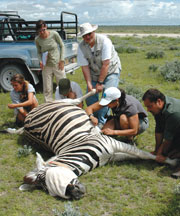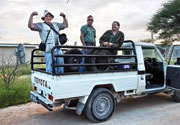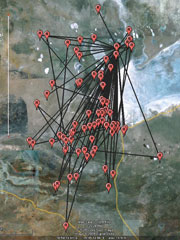Ecology and epidemiology in the age of GPS

It was 2002, and Wayne Getz stood in the midst of a modern day roundup. A helicopter roared overhead, driving a wild-eyed herd of buffalo before it.
Getz watched as eight animals hit the ground one by one, felled by tranquilizer darts aimed from above. Almost before each black body hit the ground, a team of graduate students sprinted forward with sampling vials, radio collars, and clipboards in hand.
A professor of environmental science and policy management, Getz felt, if not exactly in his element, quite pleased. He was back home in South Africa, doing hands-on conservation work with African buffalo in the world-famous Kruger Park, and he was the principal investigator of a project studying the spread of bovine tuberculosis.
All in all, it was a very strange place for a mathematician to be.
A native of South Africa, Getz grew up at a time when laws governing the separation of races were rigidly enforced. Witnessing the numberless injustices of apartheid would shape his actions for years to come. It ignited in him a keen sense of ethics and a steely determination to stand up for underdogs. A desire to leave this poisonous social environment brought him to California in 1979. “My wife and I could see the apartheid government was heading toward catastrophe, and we didn’t want to bring up our kids there,” Getz says. He joined what was then UC Berkeley’s Entomology Department, applying his mathematical skills to subjects such as pest management, insect sensory systems, and honeybee biology. His science was respected, his family was prospering, and life was generally good.

Then in 1994, the dream shared by Getz and thousands of his compatriots finally came true. Nelson Mandela was elected President of South Africa in the country’s first fully open democratic election, and apartheid was outlawed. Getz seized the moment to make changes of his own. He could now work in the country of his birth without associating with the racist regime he despised, and apply his grant money and professional influence as best he could to redress decades of social injustice.
With the decision to expand his science into wildlife conservation and Africa, “his research program went from being good to being great,” says Stephen Welter, CNR’s associate dean of instruction and student affairs. “I haven’t seen anyone else’s program change like this.”
At the core of Getz’s work is how and why animals move across the land. People have sought answers to these questions for time immemorial - at first to improve success in the hunt and harvest, and much later to understand animals in and of themselves. His approach combines a mathematician’s genius for analysis with hands-on wildlife research. This unique perspective is revealing that animal travel patterns can provide a great number of insights into animal behavior, ecology, and epidemiology.
In recent years, the advent of global positioning system technologies, coupled with expanded telecommunications networks, have added up to a revolution in animal tracking. The modern version of the radio collar can map an animal’s position to within a couple of meters every few minutes, upload the stored data automatically to a satellite or cell phone network, and allow biologists to track the beast from afar for many weeks.
Getz employs this flood of information to deduce an animal’s inner motivations. “We try to put ourselves under the skin of the animal and think how the animal would think,” Getz says.

To do this, he and his students superimpose the animal’s path on satellite maps of topography, vegetation, soil types, watercourses, or other geographical features. Using mathematical tools they have developed, researchers can then identify significant shifts in turning angles, step sizes, and velocity. Together, these data layers can reveal changes in an animal’s intentions. For example, a giraffe that veers off in a completely different direction may have spotted a tasty thorn tree, avoided a cliff, or wanted to rest in a bank of shade. Velocity data can reveal the last time an elephant paused to drink or fled from a predator. Each action then can be correlated to times of day, season, and features on the landscape to give unprecedented insights into an animal’s life cycle.
Just as an animal’s wanderings reveal its relationship with the landscape, they can also shed light on its social interactions, enabling scientists to study how herds merge and split, mates meet, and juveniles leave their parents for new groups. As it happens, this type of contact information is the same type of data needed to study the transmission of disease, or epidemiology.
Animal epidemiology is what led Getz to recreate the Wild West on the African veldt. By the early 1990s, a bovine tuberculosis outbreak in domestic cattle had leapt into herds of African buffalo at the southern boundary of Kruger National Park. It had spread to the heart of the 200-mile long reserve and was now sickening predators such as lions and leopards.
Before controlling the disease, scientists needed to learn how it spread. Getz had both the movement ecology background and the analytical modeling skills to get the job done. “The ecological factors that influence movement and the spread of the disease are all tied together,” Getz says. He designed a study to randomly sample herds for positive cases of TB as well as to track the health and movements of individuals over time. With this information, Getz could model how the infection spreads and whether a vaccination program might help. He found that because more than half of all herds carry the disease, at least 70 percent of buffalo in the Kruger and neighboring parks would need inoculations to stem the outbreak. Such an undertaking would be impractical and expensive, particularly since TB does not appear to threaten the buffalo population.
Getz is applying the same approach to understand anthrax outbreaks in Namibia’s Etosha National Park. Every year, this soil pathogen strikes down both zebra and elephants in different seasons. Getz’s students are following individuals of both species to reconstruct their encounters with the microbe. Animals tend to ingest anthrax spores by grazing on contaminated material. Dying victims bleed profusely into the soil due to an anticoagulant produced by the microbe. Getz’s group is studying how these contaminated carcasses link seasonal outbreaks of the disease. Extra nutrients from the blood could literally make grasses greener and more attractive to eat after the start of the next rainy season. But these same areas might turn into infectious hotspots when herbivores graze infected vegetation.
In this project, Getz’s students have even begun tracking the local scavengers. Vultures and jackals could be spreading anthrax by concentrating the spores in their dung. “We know enough about individual animals to begin to put a bigger story together,” Getz says.
When Getz works in Africa, he doesn’t just do science. He includes a social facet in every one of his programs. “He has come to believe that science has responsibilities to people and the natural environment,” Welter says. “He’s working hard to give back to Africa.”
That’s particularly true in education. Getz co-founded and secured international funding for a center in epidemiological modeling and analysis at South Africa’s Stellenbosch University, and works alongside his wife Jennifer on eduWeavers, the nonprofit she founded to bring students and professionals from the United States to meet and partner with students and schools in South Africa. And instead of hiring field assistants for his projects, he recruits local conservation biology graduate students, paying their school fees, awarding them stipends for fieldwork, and covering the costs of their research. In Namibia, where the average per capita income is less than $7,000 USD, Getz’s support can mean the difference between a student leaving school to support her family, and advancing her education. “Each individual you train, their value is very high, as they might be one of only three masters’ students in conservation graduating in Namibia that year,” Getz says.
At Berkeley, the same degree of caring is just as evident. Though Getz’ research group is among the largest in the college, he’s still managed to foster a friendly atmosphere where students help one another. “Being part of his lab feels like being part of the family,” says Karen Levy, a former Getz graduate student now with the Rollins School of Public Health at Emory University.
As a mentor, says former Getz graduate student George Wittemeyer, now a professor with Colorado State University, Getz is without peer. “Sometimes the mentor gets confused about who it benefits. But Wayne will tell the wholehearted, honest truth about what’s best for me without that bias. That’s very rare and a reason I feel so fortunate with Wayne.”
Meanwhile, Getz’s principled actions have earned him loyalty and respect around campus. When biologist Ignacio Chapela was denied tenure in 2003, Getz protested what he saw as a violation of the process. “Even though he wasn’t invested in any of the individuals involved, Wayne took a stand and said this is not correct. It was very risky. But he knows the ethical lines, and if matters get beyond that, he’s like a bulldog that refuses to give ground,” Wittemeyer says. In the end, Berkeley granted Chapela tenure.
Getz watched as a student pushed a syringe of antidote into the haunch of the last buffalo, then scrambled for cover. The animal opened a bewildered eye, raised its U-horned head, and heaved its 1,700-pound body upright. It trotted off to follow its herd, a thick leather transmitter collar now buckled around its muscular neck. As it disappeared into the tall grass, Getz turned away, knowing that he would be watching over this cow and her kind for many months to come.
